05 JUILLET
- INDI-UNI : 
PRE-INSCRIPTION : 15 Juin – 15 Août
PRE-REGISTRATION: June 15th - August 15th
- ROYAUME UNI – 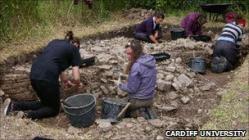
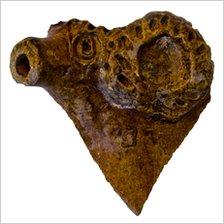 Cosmeston - A 13th Century pottery vessel found in the Vale of Glamorgan could indicate a thriving local craft in medieval times. Several fragments of the aquamanile, decorated with a ram's head, were discovered at the site of a manor house at Cosmeston, near Penarth. The vessels were used by guests to wash their hands at the dinner table. The pottery shards were found just outside the original manorial hall, amongst the debris of a large and well built medieval building. The archaeologists have identified the pottery as Vale Ware, examples of which have been found at sites across south Wales. Prof Hines agreed that the discovery shed new light on the fate of the de Costentin family, who were lords of the manor until they were displaced in the mid 1310s."It shows they weren't the family of a poor knight on their uppers, but living a much better life than we'd previously thought," he said. "It's easy to presume they would have imported their tableware from Bristol and elsewhere.
Cosmeston - A 13th Century pottery vessel found in the Vale of Glamorgan could indicate a thriving local craft in medieval times. Several fragments of the aquamanile, decorated with a ram's head, were discovered at the site of a manor house at Cosmeston, near Penarth. The vessels were used by guests to wash their hands at the dinner table. The pottery shards were found just outside the original manorial hall, amongst the debris of a large and well built medieval building. The archaeologists have identified the pottery as Vale Ware, examples of which have been found at sites across south Wales. Prof Hines agreed that the discovery shed new light on the fate of the de Costentin family, who were lords of the manor until they were displaced in the mid 1310s."It shows they weren't the family of a poor knight on their uppers, but living a much better life than we'd previously thought," he said. "It's easy to presume they would have imported their tableware from Bristol and elsewhere.
http://www.bbc.co.uk/news/uk-wales-south-east-wales-14035383
- EGYPTE – 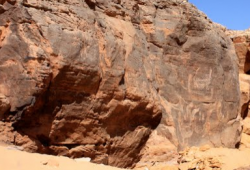 Assouan - Egypt’s Antiquities Authority says archaeologists have unearthed a 5,200-year-old rock drawing depicting a royal festival during Ancient Egypt’s earliest dynasty. The ministry says the scenes were part of a series of rock drawings featuring hunting, fighting and celebrations along the banks of the Nile River. Antiquities chief Zahi Hawass said in a statement Monday the scenes represent the first unearthing of a complete drawing of a royal festival during Dynasty Zero, when the earliest foundations of Ancient Egyptian culture are believed to have been formed. A joint U.S.-Italian expedition team discovered the unique drawings in the southern city of Aswan, a hub of archaeological treasures.
Assouan - Egypt’s Antiquities Authority says archaeologists have unearthed a 5,200-year-old rock drawing depicting a royal festival during Ancient Egypt’s earliest dynasty. The ministry says the scenes were part of a series of rock drawings featuring hunting, fighting and celebrations along the banks of the Nile River. Antiquities chief Zahi Hawass said in a statement Monday the scenes represent the first unearthing of a complete drawing of a royal festival during Dynasty Zero, when the earliest foundations of Ancient Egyptian culture are believed to have been formed. A joint U.S.-Italian expedition team discovered the unique drawings in the southern city of Aswan, a hub of archaeological treasures.
http://www.washingtonpost.com/world/middle-east/5200-year-old-rock-drawings-of-earliest-ancient-egyptian-celebrations-unearthed/2011/07/04/gHQAw07kxH_story.html
- VIET-NAM – 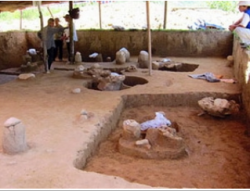 Quang Ngai - Antiques from the pre-Sa Huynh culture have been unearthed at a mountainous site in the central province of Quang Ngai. Researcher Doan Ngoc Khoi, from Quang Ngai Museum, said 10 tombs containing objects from 3,000 years ago had been found at an archaeological site in the bed of Nuoc Trong Lake, in the Tay Tra District. The antiques were similar to those of the pre-Sa Huynh culture period, which helped confirmed that such a culture flourished even in mountainous areas. Previously, antiques of that time had been found only on the plains and in coastal areas. Archaeologist Nguyen The Phong noted the objects bore unique decorative fine patterns, which were similar to objects found at another site in Pho Thanh Commune, Duc Pho District, in the same province. Yet they were somewhat different with distinctive features of the locality. Scientists worked at the site for two months before finding the objects. Sa Huynh culture flourished in central and southern Viet Nam between 1,000BC until the late second century. It is one of the three ancient cradles of civilization in Viet Nam. The Sa Huynh people are thought to be predecessors of the Cham, the founders of the Champa Kingdom that flourished in the country from 132 AD until the 18th century. –
Quang Ngai - Antiques from the pre-Sa Huynh culture have been unearthed at a mountainous site in the central province of Quang Ngai. Researcher Doan Ngoc Khoi, from Quang Ngai Museum, said 10 tombs containing objects from 3,000 years ago had been found at an archaeological site in the bed of Nuoc Trong Lake, in the Tay Tra District. The antiques were similar to those of the pre-Sa Huynh culture period, which helped confirmed that such a culture flourished even in mountainous areas. Previously, antiques of that time had been found only on the plains and in coastal areas. Archaeologist Nguyen The Phong noted the objects bore unique decorative fine patterns, which were similar to objects found at another site in Pho Thanh Commune, Duc Pho District, in the same province. Yet they were somewhat different with distinctive features of the locality. Scientists worked at the site for two months before finding the objects. Sa Huynh culture flourished in central and southern Viet Nam between 1,000BC until the late second century. It is one of the three ancient cradles of civilization in Viet Nam. The Sa Huynh people are thought to be predecessors of the Cham, the founders of the Champa Kingdom that flourished in the country from 132 AD until the 18th century. –
http://vietnamnews.vnanet.vn/Life-Style/213006/3000-year-old-artifacts-found-in-central-region.html
- FRANCE – 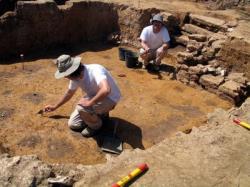 Château Thierry - Belles trouvailles des archéologues aux Vaucrises : les vestiges gallo-romains mis au jour révèlent un cœur de ville daté de 2000 ans.Ils enchaînent les belles surprises, les archéologues castels. Après avoir découvert les vestiges d'un château seigneurial à Nogent-l'Artaud, 90 sépultures sous l'ex-école privée de la Madeleine et une ferme à la Moiserie, voilà qu'ils viennent de mettre au jour de superbes vestiges gallo-romains aux Vaucrises. « Nous avons découvert trois caves ateliers de 5 m sur 5 m, proches les unes des autres et alignées, c'est typique d'un aménagement urbain à la romaine », se réjouit Sébastien Ziegler, responsable de l'unité archéologique castelle. Dans l'une des caves, un superbe escalier en dalles de grès très bien conservé. Les caves ou ateliers laissent aussi apparaître la présence d'un ancien four. Des taches noires sur le sol décapé indiquent que nos ancêtres devaient y conserver de gros récipients garnis de grains, de sauce. Des restes de céramique et un très bel élément de harnachement en bronze, orné d'un dauphin, ont aussi été découverts. « Il faut imaginer des maisons au-dessus de ces caves, un habitat dense. Les techniques de construction et d'entretien du bâtiment sont inédites sur Château-Thierry. Elles renforcent l'idée que sur cette butte aux Vaucrises, il y avait une ville romaine, la première ville édifiée sur la cité castelle, bien avant la ville qui s'est construite autour du vieux château à l'époque médiévale. » Une sacrée découverte pour les archéologues qui n'ont que très peu d'occasion de venir travailler aux Vaucrises. Au fil de leurs fouilles, ils s'approchent un peu plus de la « vie des gens » et redessinent le contour de la ville antique : « On peut supposer qu'il y avait là un axe de circulation », ajoute le spécialiste en pointant du doigt un lopin de terre bien différent de la route actuelle.Ces vestiges se situent à environ deux mètres sous terre. Pour les exhumer (le chantier a débuté en mars et s'est arrêté ces jours-ci), il a fallu ôter 1,30 m de remblai.
Château Thierry - Belles trouvailles des archéologues aux Vaucrises : les vestiges gallo-romains mis au jour révèlent un cœur de ville daté de 2000 ans.Ils enchaînent les belles surprises, les archéologues castels. Après avoir découvert les vestiges d'un château seigneurial à Nogent-l'Artaud, 90 sépultures sous l'ex-école privée de la Madeleine et une ferme à la Moiserie, voilà qu'ils viennent de mettre au jour de superbes vestiges gallo-romains aux Vaucrises. « Nous avons découvert trois caves ateliers de 5 m sur 5 m, proches les unes des autres et alignées, c'est typique d'un aménagement urbain à la romaine », se réjouit Sébastien Ziegler, responsable de l'unité archéologique castelle. Dans l'une des caves, un superbe escalier en dalles de grès très bien conservé. Les caves ou ateliers laissent aussi apparaître la présence d'un ancien four. Des taches noires sur le sol décapé indiquent que nos ancêtres devaient y conserver de gros récipients garnis de grains, de sauce. Des restes de céramique et un très bel élément de harnachement en bronze, orné d'un dauphin, ont aussi été découverts. « Il faut imaginer des maisons au-dessus de ces caves, un habitat dense. Les techniques de construction et d'entretien du bâtiment sont inédites sur Château-Thierry. Elles renforcent l'idée que sur cette butte aux Vaucrises, il y avait une ville romaine, la première ville édifiée sur la cité castelle, bien avant la ville qui s'est construite autour du vieux château à l'époque médiévale. » Une sacrée découverte pour les archéologues qui n'ont que très peu d'occasion de venir travailler aux Vaucrises. Au fil de leurs fouilles, ils s'approchent un peu plus de la « vie des gens » et redessinent le contour de la ville antique : « On peut supposer qu'il y avait là un axe de circulation », ajoute le spécialiste en pointant du doigt un lopin de terre bien différent de la route actuelle.Ces vestiges se situent à environ deux mètres sous terre. Pour les exhumer (le chantier a débuté en mars et s'est arrêté ces jours-ci), il a fallu ôter 1,30 m de remblai.
http://www.lunion.presse.fr/article/autres-actus/fouilles-archeologiques-a-la-rotonde-mise-au-jour-de-vestiges-dune-ville-antiqu
- SRI LANKA – Mihintale - Archaeological Officers complained that the flower table which gave fashion and beauty to the Black Water pond at Mihintale Sacred Area has been lost. A craving of a lotus flower was made coming out of the middle of the flower table was two and half feet long and one and half feet tall. According to the Archaeological officers this is a very rare and valuable flower table,
http://print.dailymirror.lk/news/news/49114.html
- INDE – 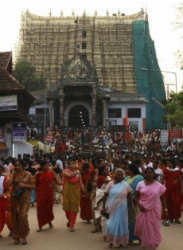 Sree Padmanabhaswamy - Unearthing treasures has been an obsession of archaeologists, as famous film 'Indiana Jones' depicts. A treasure hunt overdrive has led Indian officials to unearth treasures worth $23 billion from underground chambers in the centuries-old Sree Padmanabhaswamy temple in Kerala. It has been known that officials unearthed only five of the six secret subterranean vaults of the 16th century Hindu temple. Recently, it has been reported that while unearthing one of the six vaults at the temple, officials found a golden idol of Mahavishnu, with a height of about one foot, and a golden 'anki' that weighs close to 30 kilograms. The golden ‘anki' used to adorn the presiding deity, who is in the eternal sleep posture. In addition, investigators discovered numerous coins issued in the early 16th century. The wealth from these vaults, which was opened after almost 136 years, has made Sree Padmanabhaswamy temple the richest temple in India. Earlier, Tirumala Venkateswara Temple in Tirupati, Andhra Pradesh; Golden Temple in Amritsar, Punjab; and the Shirdi Sai Baba shrine in Maharashtra were believed to be the richest temples in the country. The Sree Padmanabhaswamy temple was built in the 16th Century by the kings who ruled over the then kingdom of Travancore. Local legends say the Travancore kings sealed immense riches within the thick stone walls and vaults of the temple. In India normally devotees donate gold and other precious objects as gifts to several temples as part of their pilgrimage to get the blessings of the God. This has led to billions of dollars worth of wealth existing in several temples of India.
Sree Padmanabhaswamy - Unearthing treasures has been an obsession of archaeologists, as famous film 'Indiana Jones' depicts. A treasure hunt overdrive has led Indian officials to unearth treasures worth $23 billion from underground chambers in the centuries-old Sree Padmanabhaswamy temple in Kerala. It has been known that officials unearthed only five of the six secret subterranean vaults of the 16th century Hindu temple. Recently, it has been reported that while unearthing one of the six vaults at the temple, officials found a golden idol of Mahavishnu, with a height of about one foot, and a golden 'anki' that weighs close to 30 kilograms. The golden ‘anki' used to adorn the presiding deity, who is in the eternal sleep posture. In addition, investigators discovered numerous coins issued in the early 16th century. The wealth from these vaults, which was opened after almost 136 years, has made Sree Padmanabhaswamy temple the richest temple in India. Earlier, Tirumala Venkateswara Temple in Tirupati, Andhra Pradesh; Golden Temple in Amritsar, Punjab; and the Shirdi Sai Baba shrine in Maharashtra were believed to be the richest temples in the country. The Sree Padmanabhaswamy temple was built in the 16th Century by the kings who ruled over the then kingdom of Travancore. Local legends say the Travancore kings sealed immense riches within the thick stone walls and vaults of the temple. In India normally devotees donate gold and other precious objects as gifts to several temples as part of their pilgrimage to get the blessings of the God. This has led to billions of dollars worth of wealth existing in several temples of India.
http://www.ibtimes.com/articles/174366/20110705/india-treasure-unearth-temple-sree-padmanabhaswamy-temple-thiruvananthapuram-kerala-16th-century-ind.htm
- INDE – Delhi - Mughal prince Dara Shikoh's library, the Malcha Mahal hunting lodge of Firoz Shah Tughlaq and some ancient gateways are among the 15 neglected monuments that will get a new lease of life with the Delhi government planning to conserve and restore them after the monsoon season. Other prominent monuments among the 15 include the gateways at Badarpur on the outskirts of Delhi, the Bagichi Ki Masjid in Mehrauli, the gateway of the garden in the Qudsia area of north Delhi. The conservation of these sites had to be done in two phases. After the first phase, comprising preparation of site plans, documentation and photography, is completed, the second will entail structural and chemical conservation, landscaping and illumination. Besides using old techniques, expert masons from Rajasthan, Agra, Chhattisgarh and Madhya Pradesh will be called to work on them.
http://mangalorean.com/news.php?newstype=local&newsid=249370